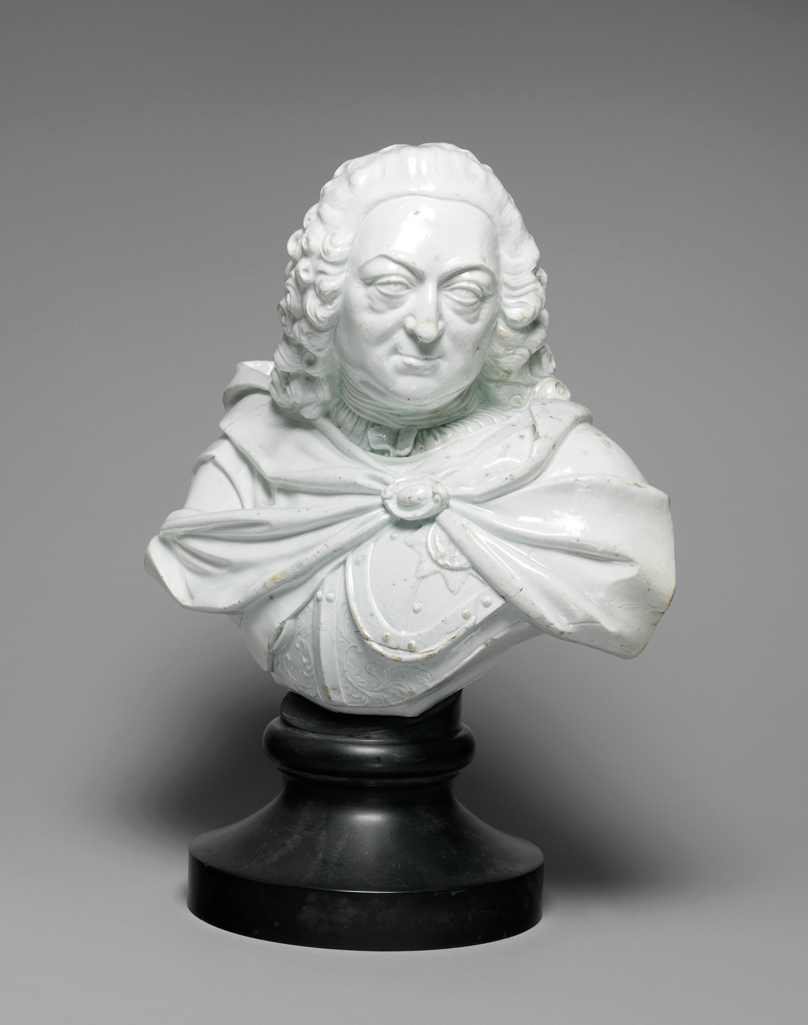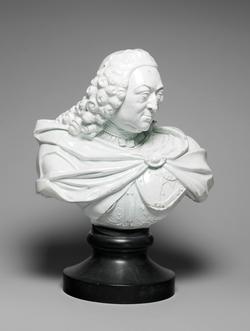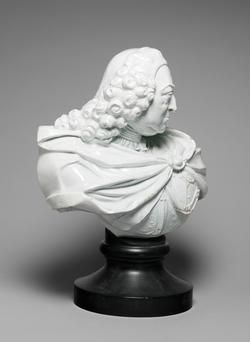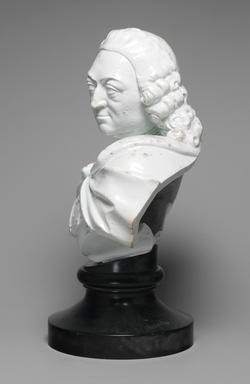Current Location: In storage
Titles
Bust of George II (ruled 1727-60)
Maker(s)
Factory:
Bow Porcelain Manufactory
(Probably)
Factory:
Vauxhall Porcelain Factory
(Perhaps)
Factory:
Richard Chaffers & Co.
(Perhaps)
Entities
Categories
Description
Soft-paste porcelain bust of George II, bewigged, and wearing armour, the Garter Star, and a cloak draped about his shoulders and fastened with an oval cabochon brooch, supported on an associated black marble socle
Soft-paste porcelain bust of George II, press-moulded, and coated inside and outside with very pale greyish-blue lead-glaze. The glaze has many brown speckles. The back of the bust below the shoulders is open, and the marks of paring away of the clay to make the wall thinner are visible. The narrow base has a large circular hole to facilitate its attachment to a socle. A small shallow fragment from another object has adhered to the underside of the right shoulder. The King faces front with his head turned three-quarters to his left. He has a long curling wig, and wears a shirt and neckcloth under armour, the breastplate of which is ornamented with scrolls and foliage. Over his left shoulder plate is the Star of the Order of the Garter, partly concealed by a cloak which is drawn in folds around his shoulders, and is held together above the Order by an oval cabochon brooch. The circular black marble socle is associated.
Notes
History note: Uncertain before Roger Francis Lambe (1872-1951), London
Legal notes
Bequeathed by R.F. Lambe
Measurements and weight
Height: 44.5 cm
Acquisition and important dates
Method of acquisition: Bequeathed
(1951)
by
Lambe, Roger Francis
Dating
18th Century, Mid
George II
Circa
1745
CE
-
1760
CE
Note
Nineteen examples of this bust of George II (1683-1760) have been recorded. The Fitzwilliam's bust lacks both the socle found with some examples, and the rococo style wall bracket to support it, which is more rare. Their attribution is contentious. Since the 19th century they been variously attributed to Chelsea, Plymouth. Bow, Worcester, Chaffers Liverpool, and most recently Vauxhall. On accession this bust was attributed to Chelsea, although its glaze is unlike Chelsea porcelain. It was reattributed to Richard Chaffers' Factory, Liverpool, by Dr Bernard Watney in 1968. This reattribution rested on spectrographic analysis of two examples respectively in the British Museum and in Dr Watney's collection. These showed that the body contained soapstone (steatite), which suggested Liverpool as a possible place of manufacture. Worcester porcelain is also steatitic, but as that factory made very few figures the bust is unlikely to have been made there. More recently the Vauxhall factory which also made steatitic soft-paste, has been adopted as an alternative. Accepting any of these three attributions would place the busts' date of manufacture in the late 1740s or 1750s, as it seems unlikely that they were made after the King's death. Analysis of early products of the Bow factory have indicated that some of them contained steatite, and that therefore this bust might equally have been made by the Bow factory before its establishment in the New Canton factory in Essex. This would place its date in the mid 1740s when the King was popular after his participation in the Battle of Dettingen in 1743 and the defeat of the Stuart Rebellion of 1745-6. The two most recent publications on the busts, Bimson, 2011, and Daniels and Ramsay, 2013 weigh these possibilities, and give the current locations of the recorded examples.
School or Style
Rococo
People, subjects and objects depicted
Components of the work
Bust
Height 34.8 cm
Width 30.5 cm
Materials used in production
presumed lead, appearing pale greyish-blue especially inside
Lead-glaze
probably steatitic
Soft-paste porcelain
Techniques used in production
Press-moulding
: Soft-paste porcelain (probably steatitic), press-moulded, and coated inside and outside with very pale greyish-blue lead-glaze, which has bubbled, particularly on the shoulders, and, here and there, where these have burst, small craters. The glaze also has many brown speckles. The back of the bust below the shoulders is open, and the narrow base has a large circular hole to facilitate its attachment to a socle. A small shallow glazed fragment, presumably from another object or prop has adhered to the underside of the right shoulder.
Glazing (coating)
Inscription or legends present
- Text: 8
- Location: On base
- Method of creation: Incised
- Type: Factory mark
References and bibliographic entries
-
Plagiarism Personified? European Pottery and Porcelain Figures
page(s): 18
-
The Bust of George II
page(s): 236-48
-
The King, the Nun and other Figures
page(s): 48
-
Catalogue of the Collection of English Porcelain in the Department of British and Mediaeval Antiquities and Ethnography of the British Museum
page(s): 36
-
Chelsea and other English Porcelain, Pottery and Enamel in the Irwin Untermyer Collection
page(s): 17
-
Rococo: Art and Design in Hogarth's England
page(s): 253-4
-
Victoria and Albert Museum Department of Ceramics, Catalogue of English Porcelain, Earthenware, Enamels and Glass collected by Charles Schreiber Esq., M.P., and the Lady Charlotte Elizabeth Schreiber, and presented to the Museum in 1884, Volume I, Porcelain
page(s): 34
-
English Enamels and British and Irish Ceramics
-
Ceramics from the Rous Lench Collection including British Pottery and Porcelain, Dutch Delft . . .
page(s): p. 225
-
A Porcelain Bust of George II
page(s): 549-54
-
Some Baroque sources of English ornamental porcelains
page(s): 123-46
-
The George II Busts and Historic Wall Brackets
page(s): 54
-
Alumni cantabrigienses: a biographical list of all known students, graduates and holders of office at the University of Cambridge, from the earliest times to 1900
Related exhibitions
Identification numbers
Accession number: C.7-1951
Primary reference Number: 39296
Stable URI
Audit data
Created: Saturday 6 August 2011
Updated: Tuesday 30 April 2024
Last processed: Tuesday 13 May 2025
Associated departments & institutions
Owner or interested party:
The Fitzwilliam Museum
Associated department:
Applied Arts









